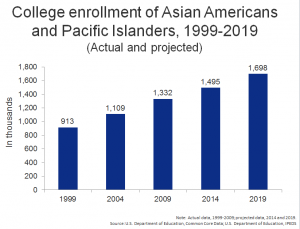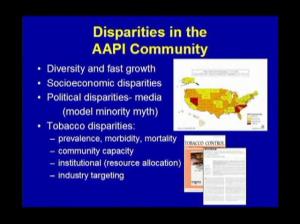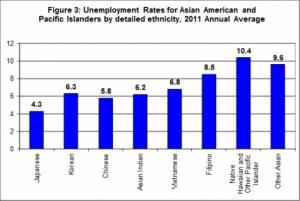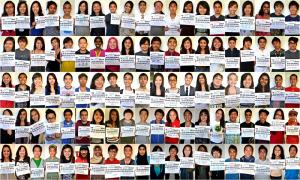
WASHINGTON (AP) - Taken together on paper, Asian-Americans and Pacific Islanders appear to be a high-achieving bunch with few of the challenges faced by other racial and ethnic minorities in the U.S. when it comes to education.
Break these populations down into their many ethnic groups, however, and stark disparities emerge.
For example, between 2006 and 2010, about three-quarters of Taiwanese-Americans and more than half of Korean-Americans aged 25 and older had earned bachelor's degrees, but only 10 percent of Samoans and 12 percent of Laotian-Americans in that same age range had done so - large gaps that frequently go unseen.
Asian-American and Pacific Islander professionals spent two days in Washington last week puzzling over these types of disparities, and how schools and educational institutions can best deal with them. Some groups are so small in number that gathering data on them can inadvertently violate the privacy of specific children and their families, said Don Yu, special adviser to Education Secretary Arne Duncan.
Last year, the Education Department sent out a request for ideas on how to best tease out and collect data on the many Asian-American and Pacific Islander ethnicities, as well as information on what is already being done in some states, cities and school districts. Those ideas were discussed during the meeting.

Asian-Americans are often very visible academically, such as the spelling bee champion whose family emigrated from India, the class valedictorian of Japanese descent or the Chinese-American champion at the science fair. But such successes mask the academic woes of others, such as Cambodians and Native Hawaiians, said Kiran Ahuja, executive director of the White House Initiative on Asian Americans and Pacific Islanders.
Unlike blacks and Hispanics who often emphasize success stories within their communities to dispel stereotypes, Asian-Americans and Pacific Islanders find they must draw attention to the less-successful among them to move beyond the "model minority" myth so struggling groups can get the help they need, said Robert Teranishi, an associate professor at New York University.
"Of course we take a lot of pride in the success of individuals in the Asian-American/Pacific Islander community, but what we try to emphasize is we do a disservice not looking at the full breadth of circumstances and the different experiences of all these individuals," Ahuja said.
At the crux of the problem is how data on Asian-Americans and Pacific Islanders are collected and kept. The Census Bureau collects information on more than two dozen specific Asian cultures. The Education Department separated Asian-Americans from Pacific Islanders and Native Hawaiians for data collection in 2007 - a move many communities feel still didn't go far enough, Ahuja said.

The demand for more specific data has intensified as the growth in the number of Asian-Americans and Pacific Islanders has outpaced that of the U.S. population in general.
The Asian population expanded more than four times faster than the overall U.S. population between 2000 and 2010, according to the Census Bureau. Native Hawaiian and Pacific Islanders increased more than three times faster than the U.S. population over that period, Census officials reported.
For example, the detail shows that while Bhutanese - who hail from the South Asian country of Bhutan - are a tiny segment of Asian-Americans, they had the fastest growth. Their ranks expanded exponentially, from less than 200 in 2000 to more than 18,000 in 2010. Their educational outcomes would be folded in with other Asian-American groups.
The Census has collected education information about some of the Asian-American and Pacific Islander groups. Nicholas Jones, the bureau's chief of racial statistics, said they show the dynamic differences between Asian ethnic groups, particularly the disparities in education, which helps predict economic well-being and guides governments in allocating education money and implementing education programs.

The data from the 2010 Census and annual American Community Survey "really inform us about the diversity of myriad groups in the United States ... These highlight the importance of data disaggregation and the need for detailed data on various groups," Jones said.
The University of Hawaii System, made up of three universities and seven community colleges, has been separating out data on Asian-Americans and Pacific Islanders for a number of years, said Pearl Imada Iboshi, director of the Institutional Research and Analysis Office for the University of Hawaii System.
The system began collecting more detailed data in response to public concern about lower levels of education attainment and income among Native Hawaiians and some Asian groups, particularly Filipinos who were the most recent arrivals to Hawaii.
The more detailed statistics show the six-year graduation rate was 9 percentage points lower for Native Hawaiians than other groups at the flagship University of Hawaii at Manoa, Imada Iboshi said.
Having more detailed information allowed the university system to identify the problem and look for solutions, she said.
Follow Suzanne Gamboa on Twitter
National Commission on Asian-American and Pacific Islander Research in Education
White House Initiative on Asian Americans and Pacific Islanders
Copyright 2013 The Associated Press.
